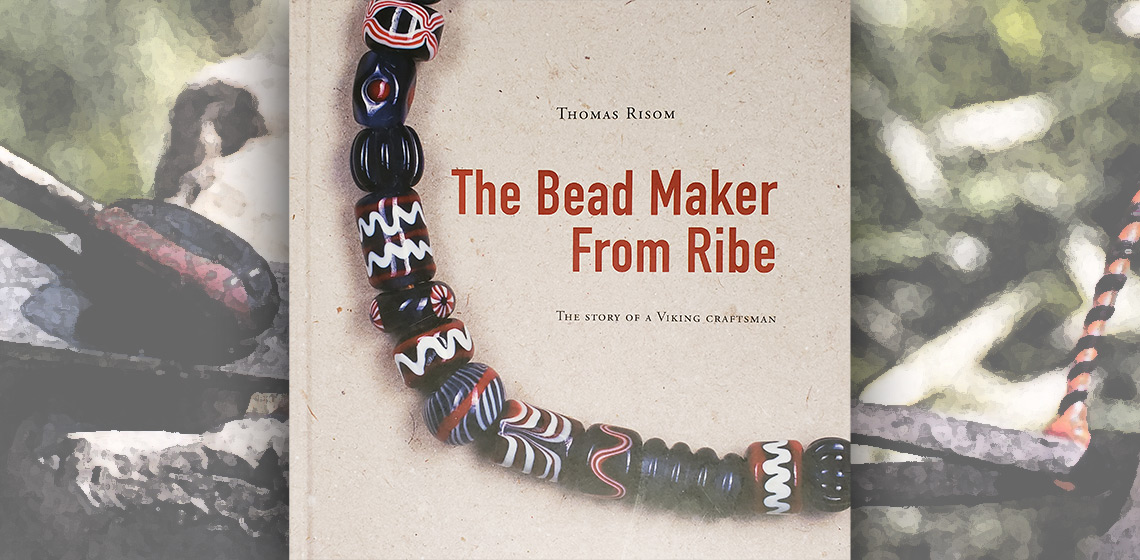
Having been involved with experimental work with Viking Era beads for a decade and a half, I am always looking for more information on the topic. Ribe is the most significant beadmaking site of the Viking Era due to its archaeological remains and the museum’s active experimental, interpretative, and craft programs. New material focusing on this site is thus of particular interest, so I was very pleased to get a copy of Thomas Risom’s The Bead Maker from Ribe.
Overall Context
To fairly review any publication, it is essential to consider its context and intentions. Risom’s book is available in the original Danish (Perlemageren fra Ribe) and in an English translation. This review is based on the English version, which contains several grammatical errors of the type expected from non-English speakers trying to cope with English’s peculiarities. This book is not a heavily footnoted academic publication, nor is it a record of the archaeological material related to beadmaking at Ribe. If either of those is what you are looking for, other sources (such as Näsman 1978 or Bencard et al 2004) will be more to your taste. What this book is, is a story of a Viking craftsman. This story creates a fictional ‘might have been’, blended from elements of the archaeological information, historical information, and the author’s own experiments and craftwork.
Examined within that context, this is precisely the sort of book I wish more museums using craftspeople would have available. It is a beautiful follow-up for someone who saw the museum’s beadmaker at work and wants to learn more. Drawings, maps, and excellent photographs accompany the easy-to-read text in this 80-page book. Books like these, focused on the different craftwork happening at open air museums, are of real value to visitors.
Book Sections
The opening sections place Ribe and the beadmaker in the context of Europe in the 700s, specifically the Frisian trade networks based out of Dorestad. It is here that the majority of the fictionalization exists, providing possible intentions, motivations, and history for a beadmaker moving into the Ribe marketplace. The layout, craft plots, buildings, activities, and interactions of people in the market are discussed here as well, with enough depth to allow us to place the beadmaker and his work comfortably in the market at Ribe.
The next sections focus on the glass itself, beginning with Ravenna in the early Roman empire through the era of Charlemagne. The author introduces the processes and materials used for making glass in the Roman world, including sources for these materials. The use of the resulting glass for mosaics and glass vessels and the suppliers of raw materials fill the rest of this section ranging from Italy to the Rhineland and across the centuries.
The book then returns to the fictional beadmaker to discuss his equipment and activities. Here, we see some excellent photographs of the archaeological material, including details not shown very well in other publications. The author clearly explains his ideas on how the beadmaker would use each of the artefacts. He also mentions other interpretations, even if only to dismiss them. Whether or not you agree with his particular ideas, the author presents a consistent system that passes the two most critical tests. It does not require anything apart from the archaeological material and produces the desired end product – beads. A wonderful touch was the author showing the difference between his pattern-welded metal tools (which would have been a massive expense in the Viking Era) and the sparse, simple remains from the archaeological record.
The final, significant section covers the steps needed to create each of the different types of beads from the archaeological context. The high quality, step-by-step photographs in this section allow the reader to follow each part of shaping and decorating specific beads, allowing them to review actions they could have seen taking place at the museum. The book closes with some personal notes and a useful bibliography for follow-up reading.
Summary
This book is short at 80 pages, and the extensive photographs significantly reduce the amount of text within the book. As a researcher in this area, I found myself regularly wanting more information about specific artefacts, or for the author to provide more context to defend some of his ideas or “perhaps” statements about the fictional beadmaker. Yet this is not fair to a book aimed at the more casual museum visitor or at someone who is just exploring the world of a Viking Era beadmaker. This book is an excellent introduction for those audiences, with a reasonable amount of depth to the background it provides and a consistent, coherent story of a beadmaker and his work.
Book information:
The Bead Maker From Ribe: The Story of a Viking Craftsman by Thomas Risom. 2020 Forlaget Trælår. ISBN: 978 879 3896017.
The book can only be purchased at the museum in Ribe (it is not available in any bookshops). If any EXARC-readers would like to purchase the book, they can contact the museum at museum@sydvestjyskemuseer.dk regarding the purchase or they can order the book from the museum's Danish webshop.
Just like the Danish edition of the book, Risom donated the English edition and the profit to the museum in Ribe.

Bibliography
Näsman, U. 1978. Die Herstellung von Glasperlen. In: M. Bencard (ed.): Wikingerzeitliches Handwerk in Ribe. Acta Archaeologica 49, 1978. København.
Bencard, Mogens, Rasmussen, Aino Kann, and Madsen, Helge Brinch. 2004. eds. Ribe Excavations 1970-76. Vol. 5. Jutland Archaeological Society Publications 4-6. Moesgard: Jutland Archaeological Society, 2004. Pp. 287.